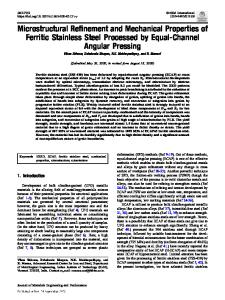Microstructural, Mechanical Properties and Corrosion Resistance of Ferritic Stainless Steel Welded by GTAW and Coated by
- PDF / 834,733 Bytes
- 9 Pages / 432 x 648 pts Page_size
- 96 Downloads / 448 Views
Microstructural, Mechanical Properties and Corrosion Resistance of Ferritic Stainless Steel Welded by GTAW and Coated by Flame Spraying J. Delgado-Venegas, A. Molina-Díaz, R.R. Ambriz-Rojas, R. Cuenca-Álvarez Instituto Politécnico Nacional CIITEC-IPN, Cerrada de Cecati S/N Col. Sta. Catarina C.P 02250, Azcapotzalco, DF, México. ABSTRACT Ferritic stainless steels are widely used in transportation industry due to their exceptional performance regarding mechanical and corrosion properties. However, after a welding process, joints feature the sensitizing phenomenon because of the heat exchange from the torch affecting mechanical properties and corrosion resistance. This work describes the behavior firstly of mechanical properties of weld joints of ferritic stainless steel as base material without and with filler material (AISI 308L) by gas tungsten arc welding (GTAW). Operating parameters such as arc voltage, welding currrent, welding speed, feed speed, shielding gas flow were evaluated. Secondly, samples of weld joints were coated by flame spraying of composite particles in order to reduce the weight loss induced by corrosion in a salt spray (fog) apparatus. Changes induced from GTAW on the heat affected zone and Thermal Spraying on corrosion resistance, were monitored by optical and scanning electron microscopy, microhardness and longitudinal tensile testing. Results show that GTAW helps to control the size and the microstructure of heat affected zone improving simultaneously the mechanical properties. Meanwhile, welded joints covered by composite coatings feature a lower damage provided that the ceramic phase has been homogeneously dispersed. INTRODUCTION Ferritic stainless steel (FSS) with low chromium content (11-12 Wt %) feature high performance in aqueous environments. However, the use of these materials has been limited by problem found during welding (1-5). Mechanical properties and corrosion resistance of FSS are affected in the heat affected zone (HAZ) due to the formation of martensite and a heterogeneous microstructure with excessive grain growth and grain refinement near to the metal base. The high relative heat input leads to the formation of chromium carbides in HAZ increasing the susceptibility to intergranular corrosion (IGC) also called sensitization (6). The interest to solve these problems is based in the wide range of automotive applications as they result in eventual failure of manufacturing components (7-10) . In another hand, some studies have reported the sensitization behavior at welded joints of ferritic stainless steel concerning the concentration gradient due to the enrichment of chromium carbides at the expense of the chromium in the nearest of grain boundaries. This region is unstable to form the passivation layer of Cr2O3, therefore it must be protected to avoid chemical reaction with the surrounding atmosphere. Thermal spraying has been commonly used to build metallic deposits. However, this kind of coatings still reacts with oxygen mainly. Currently, investigations are focused to devel
Data Loading...











